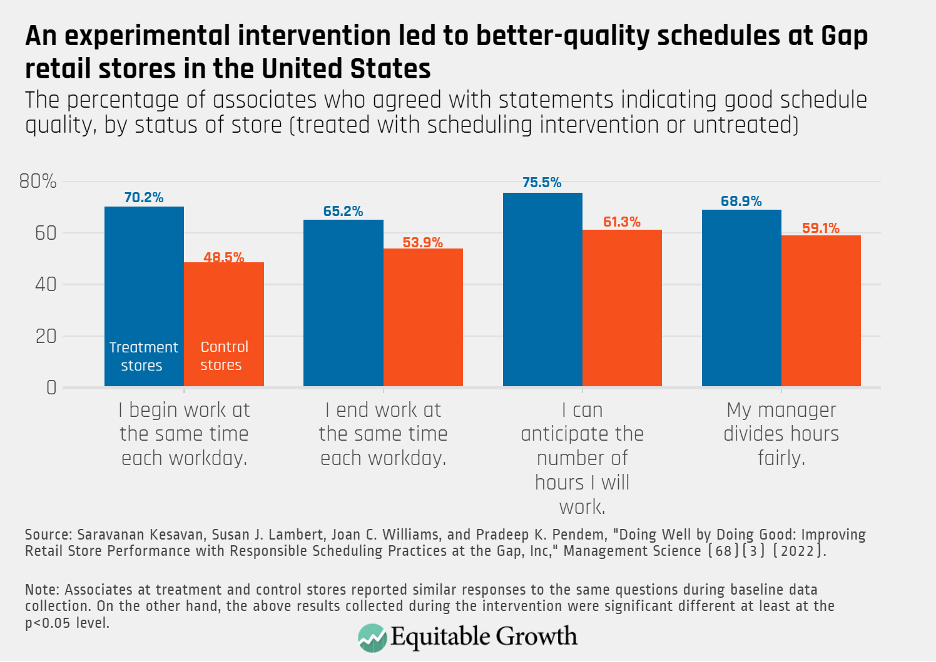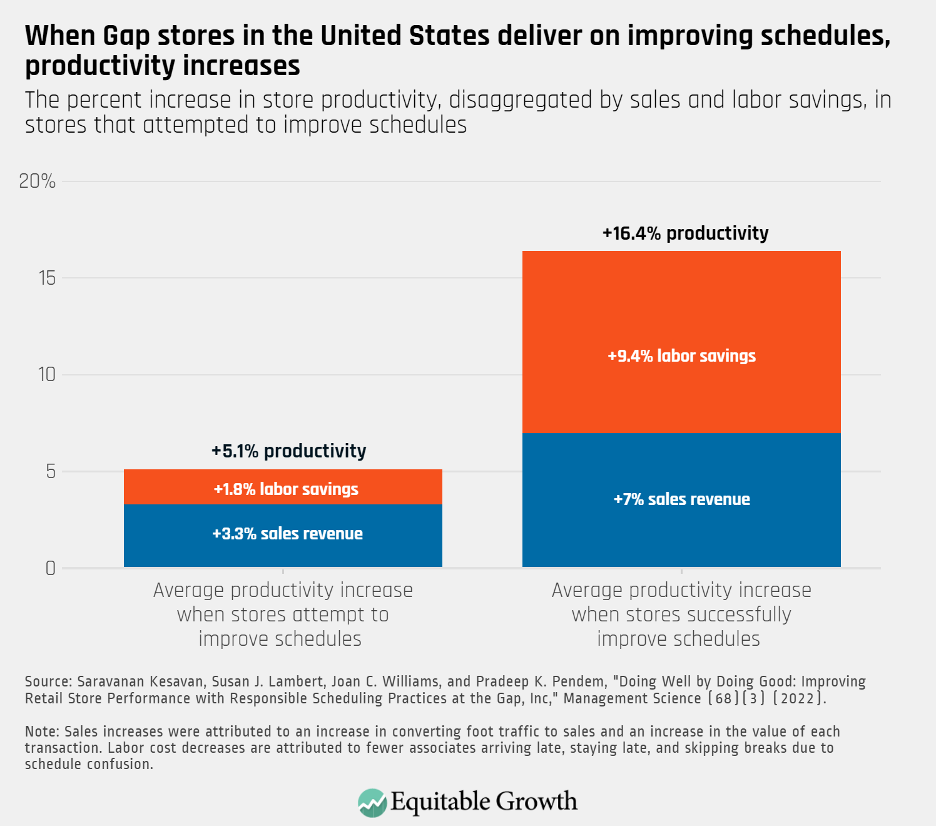New research explains how better-quality work schedules increase U.S. retail workers’ productivity and store profits

In the retail and service sectors, store managers are engaged in a perpetual balancing act to ensure that their supply of both goods and labor ebbs and flows with customers’ demands. Just as stores don’t want shelves cluttered with merchandise that no one wants to buy or empty during peak shopping seasons, they also are wary of having too many or too few employees working at any time. Too many employees, and they are paying for labor they aren’t using; too few, and they lose out on sales that are crucial to maintaining healthy profits.
Attempting to strike the right balance, many employers use complex computer algorithms that frequently alter employees’ schedules to match expected customer demand. This practice is referred to as just-in-time scheduling, and it is disproportionately experienced by workers who are women of color. Just-in-time scheduling leads to daily, weekly, and monthly work hours for employees that are unpredictable, unstable, inconvenient, and often impossible to manage.
Stores use these just-in-time schedules to shave labor costs, but prior research shows that such practices may come with unseen costs to retailers. When the clothing retailer Gap Inc. adopted a series of measures over 9 months in 2015 and 2016 to improve schedule quality as part of a randomized experiment, profits and productivity increased. Now, new research published in the journal Management Science helps explain the mechanisms behind these findings.
The study finds that when Gap workers were provided with more predictable, better-quality schedules, store productivity improved by 5.1 percent, driven by a 3.3 percent increase in sales and 1.8 percent savings in labor due to increased worker effort and reduced tardiness. The result was a win-win for workers and their employers.
As part of a study on the business implications of improved scheduling quality, 28 Gap stores in San Francisco and Chicago agreed to enroll in a randomized experiment in which 19 treatment stores were selected to implement the following five interventions:
- Fixed start and end times for shifts to ensure stable shift structure
- The establishment of a core schedule, in which associates were assigned the same shifts week to week
- A Part-Time Plus team of core associates assigned a minimum of 20 hours per week
- Targeted additional staffing budgets to use during times the researchers’ analyses indicated the store was understaffed
- Allowing employees to make tech-enabled schedule changes through a third-party app Shift Messenger, through which managers could also post new shifts or remove empty, unneeded shifts
Managers in these treatment stores committed to making good-faith efforts to implement these changes, but participation in any of the five components was voluntary. The results suggest that these interventions improved associates’ scheduling quality. (See Figure 1.)
Figure 1

The analysis of shift data and qualitative survey data revealed a modest but statistically significant improvement in the consistency of associates’ weekly hours worked. Additionally, associates in treatment stores reported more predictability in their schedules and greater control over when they did or did not work.
These changes affected the attitude of workers and the overall work atmosphere. The authors of the study describe one store manager remarking, “Overall, it’s helped the morale of the store.” And while the intervention did not result in more hours worked for associates overall, those associates in the Part-Time Plus category did see an improvement in their hours worked, and significantly more associates in treatment stores agreed that hours were assigned “fairly,” compared to associates in control stores.
These improvements in scheduling practices were a clear improvement for the workers. And these scheduling practices were beneficial to the treatment stores’ productivity in terms of overall sales and labor savings, too.
Using a so-called Intent-to-Treat model—a conservative approach that does not factor in adherence to the intervention components—the researchers found a 5.1 percent increase in store productivity in treatment stores, driven by a 3.3 percent increase in sales and a 1.8 percent decrease in labor costs. Models that accounted for stores’ adherence to the intervention estimated a much higher increase in productivity, of 16.4 percent. For comparison, the average growth in retail store productivity is approximately 2.5 percent per year. (See Figure 2.)
Figure 2

There are several mechanisms explaining why sales increased and labor costs decreased. The increase in sales is straightforward: Associates with better schedules exerted more effort in their jobs. The researchers found that associates at the treatment stores were better at converting store traffic into sales and supporting customers’ purchases of more expensive products.
Furthermore, managers suggested that stable schedules allowed the workers to become more specialized in the skills and tasks specific to their regular shifts. One store manager described this specialization with a specific example. “It’s great because if someone works every Tuesday, she knows we have the same Gap Card promotions every Tuesday,” the store manager explained. “She knows which signs to put up. Nice when you don’t have to tell them what to do.”
This may seem like a small improvement in worker productivity, yet when the signs are up quickly and efficiently, workers can focus on their interactions with customers.
In addition to increased sales, stores benefit from reduced labor costs. Importantly, this savings did not come from reductions in employees’ scheduled hours. Rather, more predictable schedules meant that employees could make consistent plans around child care, commuting times, public transportation, and other logistical factors to prevent late arrivals. Fewer late arrivals mean that store operations run smoothly, that workers don’t need to skip breaks or work longer to address disruptions to workflow, and that the company doesn’t have to pay for this extra work time.
One manager described the change he saw in schedule adherence:
I remember before someone saying: “what time do you work tomorrow?” They weren’t sure. Now, you only have two choices [during the afternoon]. It helps with stability for the associates because they can remember what time to leave to get here on time with public transportation.
As more jurisdictions across the country debate and implement Fair Workweek ordinances, which require employers to adhere to measures that are designed to improve schedule quality, the experience of these Gap stores shows that businesses also have something to gain from better schedules. Investing in employee well-being and taking simple steps to ease employees’ work-life conflicts can pay dividends for employers quickly.
These better-quality scheduling practices reveal unseen profits previously forgone in the quest for lower and lower labor costs—a reminder that the needs of employers and their employees are not inherently at odds and can be aligned for the betterment of all involved, leading to higher productivity and thus stronger and more equitable economic growth.






